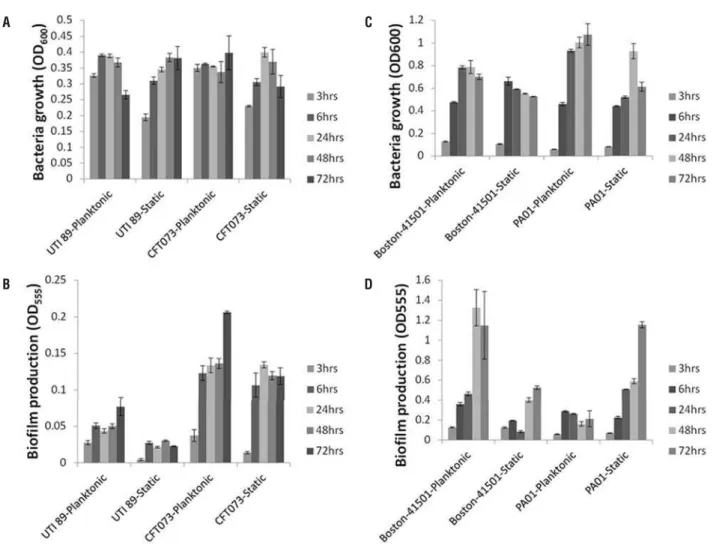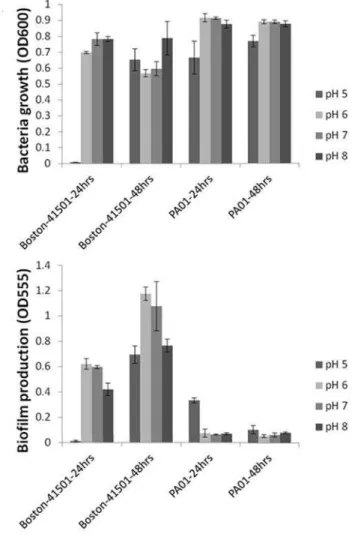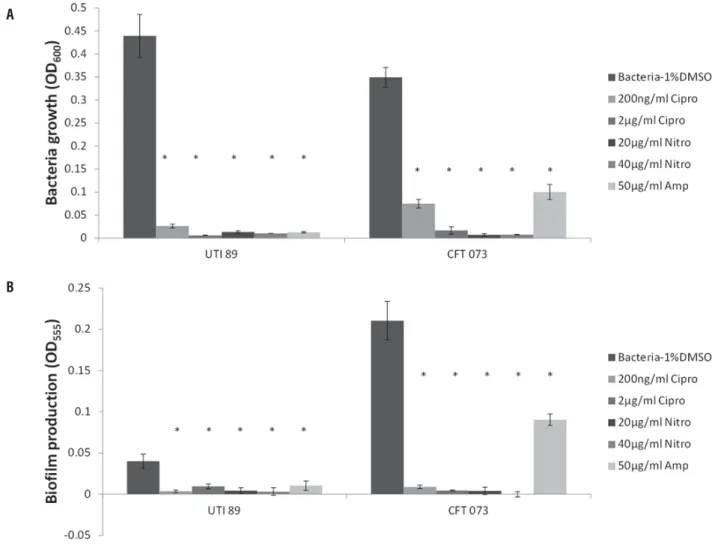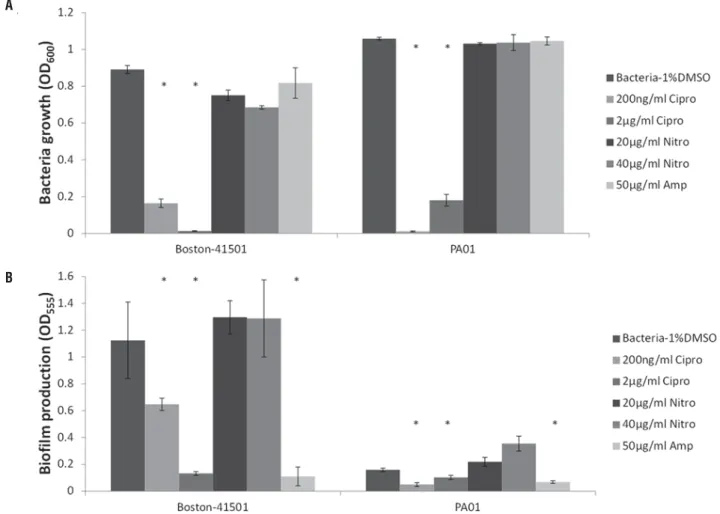The efficacy of immediate versus delayed antibiotic
administration on bacterial growth and biofilm production
of selected strains of uropathogenic Escherichia coli and
Pseudomonas aeruginosa
_______________________________________________
Leah Gandee1, Jer-Tsong Hsieh1, Vanessa Sperandio1, Cristiano G. Moreira1, Chih-Ho Lai1, Philippe E. Zimmern1
1UT Southwestern Medical Center, Dallas, Texas, USA
ABSTRACT ARTICLE INFO
______________________________________________________________ ______________________
Purpose: The treatment of urinary tract infections (UTI) with antibiotics is commonly used, but recurrence and antibiotic resistance have been growing and concerning cli-nicians. We studied whether the rapid onset of a protective biofilm may be responsible for the lack of effectiveness of antibiotics against selected bacteria.
Materials and Methods: Two established uropathogenic Escherichia coli strains, UTI89 and CFT073, and two Pseudomonas aeruginosa strains, PA01 and Boston-41501, were studied to establish a reliable biofilm formation process. Bacterial growth (BG) was determined by optical density at 600 nm (OD 600) using a spectrophotometer, while biofilm formation (BF) using crystal violet staining was measured at OD 550. Next, these bacterial strains were treated with clinically relevant antibiotics, ciprofloxacin HCl (200 ng/mL and 2 µg/mL), nitrofurantoin (20 µg/mL and 40 µg/mL) and ampicillin (50 µg/mL) at time points of 0 (T0) or after 6 hours of culture (T6). All measurements, including controls (bacteria -1% DMSO), were done in triplicates and repeated three times for consistency.
Results: The tested antibiotics effectively inhibited both BG and BF when administered at T0 for UPEC strains, but not when the antibiotic administration started 6 hours later. For Pseudomonas strains, only Ciprofloxacin was able to significantly inhibit bacterial growth at T0 but only at the higher concentration of 2 µg/mL for T6.
Conclusion: When established UPEC and Pseudomonas bacteria were allowed to culture for 6 hours before initialization of treatment, the therapeutic effect of selected anti-biotics was greatly suppressed when compared to immediate treatment, probably as a result of the protective nature of the biofilm.
Key words:
urinary tract infection; antibiotic therapy; biofilm formation; bacterial growth
Int Braz J Urol. 2015; 41: 67-77
_____________________
Submitted for publication: October 29, 2013
_____________________
Accepted after revision: June 01, 2014
INTRODUCTION
Uropathogenic Escherichia coli (UPEC) is the leading cause of urinary tract infection (UTI) and, in the United States alone, health care costs for UTI surpass $1.5 billion per year (1-4). UTIs
with UTIs are strains of E.coli and Pseudomonas aeruginosa (P.aeruginosa) respectively. Therefore, this study focused attention on well-established strains of these two bacteria.
Currently, antibiotics represent the most effective treatment against UTI. However, some patients exhibit recurrent infections and/or appe-ar to develop resistance to antibiotics (4, 6). Se-veral studies have indicated that the production of bacterial biofilm, a large bacterial community that forms following bacterial adhesion and co-lonization to surfaces and in which bacteria are held together by exopolysaccharides (7) secreted by the bacteria, contributes to antibiotic resistance (8). A mature biofilm can contain a community of cells and provide a matrix for chemical signaling and message relay between individual cells (5, 9). Thus, we were interested in determining the role of biofilm production by E.coli and P.aeruginosa bacteria strains as one of the major contributors to antibiotic resistance. To study the biofilm for-mation by bacteria treated with antibiotics, two established strains of E.coli (UTI89 and CFT073) and two well-characterized strains of P.aeruginosa (Boston-41501 and PA01) were selected.
We first determined the time course of the growth of each bacteria strain and biofilm under different culture conditions. We also examined whether different pH conditions, consistent with the range of urine pH in humans, had any impact on bacterial growth and biofilm formation. Based on these optimized culture conditions, we exami-ned the effect of clinically relevant antibiotics on the bacterial growth and biofilm formation. Fur-thermore, we evaluated whether different treat-ment schedules of antibiotics have any impact on bacterial growth and biofilm formation.
MATERIALS AND METHODS
Study Design
Following the evaluation of the impact of biofilm performance under different culture con-ditions and pH ranges, biofilm formation obtained from established strains of E.coli and P.aeruginosa was assessed in the presence of commonly used antibiotics in the treatment of urinary tract in-fections. The timing of antibiotic treatment on
biofilm formation and bacterial growth was also studied to determine the effect of delayed therapy.
Bacterial strains
E.coli UTI89 and E.coli CFT073 were obtai-ned from Harry Mobley (University of Michigan); both strains have been sequenced. E.coli UTI89 is a prototypic cystitis isolate (1) and E. coli CFT073 is a prototypical UPEC isolate cultured from blood and urine of a patient with pyelonephritis (10). P.aeruginosa-Boston 41501 was purchased from American Type Culture Collection (Manassas, VA), and P.aeruginosa-PA01 was obtained from Kevin McIver; only PA01 has been sequenced. Antibio-tics (Ampicillin, Ciprofloxacin and Nitrofurantoin) were purchased from Sigma-Aldrich (St. Louis, MO) and used at the following concentration ran-ges: Ciprofloxacin HCl (Cipro: 200 ng/mL and 2 µg/mL), Nitrofurantoin (Nitro: 20 µg/mL and 40 µg/mL), and Ampicillin (Amp: 50 µg/mL). DMSO was used as a solvent to dilute all the antibiotics. The final concentration of DMSO was 0.1%. Bio-film formation was not affected at this low con-centration of DMSO.
Determination of Minimum Inhibitory Concen-tration (MIC) by the microdilution method
MIC for E.coli and P.aeruginosa strains were assessed by varying concentrations of Ciprofloxa-cin, Nitrofurantoin, and Ampicillin assessing bac-terial growth through CFU counts as previously described (11). An adjusted inoculum of the overni-ght growth organism was introduced into LB broth containing serial dilutions in 96 well plates, from 0.0015 µg/mL to 100,000 µg/mL of an initial anti-biotic solution, with approximately 5x105 CFU/mL
inoculum. Results were observed after 18 hours of incubation at 37ºC. The MIC was defined as the lo-west concentration to inhibit visible growth (11).
(static environment (SE)) for 6-72 hours or incu-bated in LB broth with different pH environments (pH 5 to 8) for 24-48 hours. Bacterial growth was determined by optical density at 600 nm (OD6oo) using a spectrophotometer. Furthermore, serial di-lutions of culture were performed and plated for colony forming units (CFU).
For adjusting different pH in LB broth, either hydrochloric acid or sodium hydroxide was used to either decrease or increase the pH, respectively, to 5, 6, 7 and 8. Media was then filtered through a 0.2 µm sterile syringe filter (Corning, Inc., Corning, NY). Each bacterium was added into aliquots of sterile pH-adjusted media and pH was measured using pH indicator strips (EM Science, Cherry Hill, NJ) before and after incubation.
Crystal violet staining for biofilm assay
We followed the methodology for biofilm assay as previously described (8) with minor modi-fications. Briefly, after determining bacterial growth density, the supernatant was discarded, and attached bacteria and biofilm were washed twice with sterile water. The attached biofilm was stained with 100 µl of 0.4% crystal violet (Sigma-Aldrich) for 15 minu-tes at room temperature. The wells were rinsed twice with sterile water, then air dried. The biofilm-retai-ned crystal violet was eluted with 100 µl of 100% ethanol and incubated for 5 minutes at room tem-perature on a shaker (175-200 rpm). The OD555 was determined using a spectrophotometer.
Statistical analyses
Each experiment was repeated three times for consistency, with samples in triplicate. Data were presented as the mean ± SEM, and the differences between two groups compared by the Student’s t test. Statistical significance (p<0.05) was shown by asterisks (*) above the bars on the graphs.
RESULTS
Determination of culture condition for bacterial growth and biofilm production
As shown in Figure-1A, the time cour-se study indicated that the growth of both E.coli strains, UTI89 and CFT073, reached a plateau in 6
hours. The AS condition was more favorable for UTI89 while no significant difference was noted for CFT073 in either condition. For CFT073, the bio-film production gradually increased under either condition, while UTI89 formed biofilm by 6 hours which stayed fairly consistent thereafter (Figure--1B). For P.aeruginosa Boston-41501, the bacterial growth reached a plateau around 24 hours with no significant difference observed in AS or SE condi-tions (Figure-1C). In contrast, P.aeruginosa PA01 continued to grow in AS condition from 24 to 72 hours, as compared to SE condition (Figure-1C).
Overall, both Boston-41501 and PA01 P.aeruginosa strains showed more robust biofilm production than both E.coli strains (Figures 1C and D). Noticeably, under AS condition, Boston-41501 exhibited tremendous biofilm production capabili-ty in a time-dependent manner even when bacterial growth reached a plateau at 24 hours (Figure-1D). For Boston-41501, although the biofilm production pattern remained similar in both AS or SE condi-tions, the biofilm production in the SE condition was significantly lower than in the AS condition (Figure--1D). For PA01 strain in AS conditions, it appeared that biofilm production was established at 6 hours and did not increase further over time (Figures 1C and D). In contrast, for PA01 strain under SE con-dition, bacterial growth reached a plateau within 24-48 hours but biofilm continued to increase in a time-dependent manner (Figures 1C and D). Taken together, with the exception of PA01, AS conditions appeared to be more favorable for both growth and biofilm production for all the bacterial strains tested in this study.
Effect of pH
As indicated in Figure-2, the different pH levels did not affect the growth or biofilm forma-tion of our E.coli and P.aeruginosa strains, with the exception of the more acidic conditions (pH 5). P.aeruginosa strains were able to bring pH levels back to a consistent level (neutral pH) across the study at 48 hours.
Effect of antibiotics on bacterial growth and bio-film production
an-Figure 1 - Time course analysis of growth and biofi lm patterns.
A
B
C
D
tibiotic tested for our selected strains of E.coli and P.aeruginosa. Antibiotics used in this study were chosen based on their common clinical use. For Ciprofl oxacin, MIC was 100 µg/mL for all selected strains. For Ampicilin, MIC was 100,000 µg/mL for P.aeruginosa PA01, 10,000 µg/mL for P.aeruginosa Boston-41501, and 1,000 µg/mL for both E.coli strains. For Nitrofurantoin, MIC was 400 µg/mL for both P.aeruginosa (Boston-41501 and PA01) strains, 100 µg/mL and 20 µg/mL for UTI 89 and CFT 073 respectively. The dosage reported in urine is 2 µg/mL (8, 12) for Ciprofl oxacin and between 25 and 400 µg/mL for Nitrofurantoin. Therefore, to make this study relevant, we used concentra-tions of antibiotics similar to the concentraconcentra-tions found in urine, which are signifi cantly lower than the MIC. Ampicilin was used primarily as a
nega-tive control in a similar range used for the other two antibiotics.
As shown in Figures 3A and B, all antibio-tics were able to signifi cantly inhibit both bacte-rial growth and biofi lm production for both UTI89 and CFT073 at 24 hours when antibiotics were ad-ded at Time 0. For UTI89 and CFT073, Ampicilin appeared to be less effective than Ciprofl oxacin or Nitrofurantoin for inhibiting bacterial growth and biofi lm production. Taken together, for UTI89 and CFT073, antibiotics can effectively inhibit both growth and biofi lm production when administered at baseline (Table-1).
antibio-tics were added at Time 0 (Figure-4A). Interestingly, for both strains, Ciprofl oxacin at 200 ng/mL or 2 µg/ mL and Ampicilin at 50 µg/mL signifi cantly inhibi-ted biofi lm production. Surprisingly, Nitrofurantoin increased biofi lm production in both strains (Figure--4B). Antibiotics also effectively inhibited both gro-wth and biofi lm production of P.aeruginosa when they were administered at baseline (Table-1).
Subsequently, E.coli and P.aeruginosa strains were cultured for 6 hours prior to receiving antibiotic treatment for an additional 24 hours. As shown in Figures 5A and B, E.coli bacterial gro-wth and biofi lm production were not inhibited by any of the antibiotics.
For Boston-41501, Ciprofl oxacin still re-mained effective for both bacterial growth and
biofi lm production inhibition when it was added 6 hours after the initial plating of bacteria (Figures 6 A and B). However, a signifi cant inhibition of biofi lm production by Ciprofl oxacin was only detected at 2 µg/mL for the PA01 strain. Nitrofurantoin was not only an ineffi cient antibiotic for either P.aeruginosa strain but its presence stimulated their biofi lm pro-duction (Figure-6B). Ampicillin failed to inhibit bac-terial growth of both P.aeruginosa strains (Figure--6A) but it showed signifi cant inhibitory effect on biofi lm production (Figure-6B).
DISCUSSION
Recurrent urinary tract infections repre-sent a major clinical challenge as they affect a
A B
Figure 3 - Effects of antibiotic treatment on E.coli from Time 0. Asterisks (*) show statistical significance as compared to bacteria with no treatment (P<0.05).
A
B
Table 1 - Inhibition of bacterial growth and biofilm formation of E. coli and P. aeruginosa by treatment of different antibiotics at initial bacterial plating.
Antimicrobial agentsa
Determinations Bacterial strains Cipro Nitro Amp
Bacterial growth UTI89 + + +
CFT073 + + +
Boston-41501 + – –
PA01 + – –
Biofilm formation UTI89 + + +
CFT073 + + +
Boston-41501 + – +
PA01 + – +
A
B
Figure 4 - Treatment of P.aeruginosa with antibiotics from Time 0. Asterisks (*) show statistical significance as compared to bacteria not treated (P<0.05).
large proportion of women after a first UTI episo-de (13). Different theories have been proposed to explain recurrence, including periurethral coloni-zation and persistence of quiescent intracellular reservoirs inside a protective biofilm in the blad-der (14). Other factors such as estrogen deficiency, the composition of the surface glycosaminoglycan of the bladder, the host response, and the acidi-ty of the urine have also been implicated in this complex process. Even when patients are treated with culture-directed antibiotic therapy, some will develop a clinical lack of response, prompting a switch to a different antibiotic regimen after a few days, while others seem to respond initially but promptly recur after the completion of the antibio-tic treatment course. These clinical observations
suggest several plausible mechanisms, including a sub-therapeutic concentration of urinary antibio-tics to effectively eradicate the bacterial infection, or an intra-vesical mechanism of bacterial pro-tection against the antibiotics, such as a protected site for the bacteria inside a biofilm.
sub-jected to various environmental changes like mo-vement and pH variations to determine how such changes would impact the biofi lm assay results, our goal being to produce a very reliable biofi lm assay for our next study. With the exception of P.aeruginosa PA01, we found that agitated con-ditions were more conducive to bacterial growth and biofi lm formation. In general, bacterial gro-wth of E.coli UTI89 and CFT073 reached a plate-au within 6 hours after plating; however, biofi lm formation continued. Although bacterial growth between CFT073 and UTI189 was similar, CFT073 produced more biofi lm than UTI89. P.aeruginosa Boston-41501 reached a bacterial growth plateau
at 24 hours but biofi lm continued to grow in a time-dependent manner. P.aeruginosa PA01 li-kewise reached a growth plateau at 24 hours and biofi lm production reached a plateau at 6 hours in agitated conditions. However, PA01 was able to continue producing biofi lm in a time-dependent manner in static conditions (Figure-1). With our fi ndings, we established that agitated conditions would be optimal for our future work.
Since urine pH in patients varies from pH 5 to 8, we investigated whether variations in pH would impact the bacterial growth or biofi lm for-mation of each strain. Our results indicated that, except in more acidic conditions (pH 5), variations
Figure 5 - Treatment of E.coli with antibiotic after untreated growth for 6 hours. Asterisks (*) show statistical signifi cance to negative control (P<0.05).
A
in pH did not play a signifi cant role in the inhibi-tion of bacterial growth or biofi lm producinhibi-tion. For P.aeruginosa, at 48 hours, the strain of bacteria was able to overcome pH variations and neutralize the acidic conditions (Figure-2).
Equipped with a reliable biofi lm formation assay, we then tested the effect of some of the most widely prescribed antibiotics for UTI to elucidate bacterial growth and biofi lm production patterns at different time points and with different anti-biotic concentrations (8, 15). Immediate treatment of either E.coli strains with Ciprofl oxacin, Nitro-furantoin, or Ampicilin at various concentrations showed signifi cant decreases in both bacterial growth and biofi lm production (Figure-3 and Ta-ble-1). However, we observed a different behavior with both P.aeruginosa strains when treated
im-mediately with antibiotics: only Ciprofl oxacin was able to signifi cantly inhibit both bacterial growth and biofi lm production at both concentrations for both strains (Figure-4). A key fi nding of this study was that when administered at 6 hours, none of these antibiotics were able to stop E.coli bacterial growth or biofi lm formation. Furthermore, Nitro increased biofi lm production for P.aeruginosa, se-emingly serving as a nutrient factor.
Clinically, it would be diffi cult to treat patients with UTI symptoms with antibiotics im-mediately, and even so, the biofi lm may be com-pletely formed when symptoms start. This obser-vation could explain the trend to UTI recurrence in some women (16). In fact, some patients known to experience recurrent episodes of urinary tract infections are at times prescribed antibiotics to
Figure 6 - Treatment of P.aeruginosa with antibiotics after untreated growth for 6 hours. Asterisks (*) show statistical signifi cance when compared to negative control (P<0.05).
A
have on hand to treat themselves as soon as their symptoms restart. This approach has several shor-tcomings, including the potential for unnecessa-ry treatments in the absence of a culture-proven urinary tract infection and an increased risk of bacterial resistance over time. On the other hand, clinicians are sometime tempted to empirically initiate therapy while waiting for the culture re-sults to return. Considering our data in selected strains of E.coli and P.aeruginosa known for their biofilm formation performance, such a clinical decision may be very relevant. However, caution is required as one limitation of this study is the complexity of the biofilm and the challenges of extending in vitro observations to the in vivo si-tuation. Although there is mounting evidence on the role of biofilm resistance to antibiotics as part of the recurrence process (17), the data in humans remains weak.
Nitrofurantoin has recently been incrimi-nated for its long-term risks (pulmonary fibrosis, peripheral neuropathy, dosing adjustment in renal insufficiency) (18, 19) to the point that its current use requires sometimes a complex clearance pro-cess. It is important to note its counter-effect le-ading to biofilm growth stimulation in this study, which may explain its lack of initial effectiveness or durable response even in patients with culture--proven sensitivity.
In summary, antibiotics can be very effec-tive for the uropathogenic E.coli strains selected in this study if the treatment can be applied early on. For P.aeruginosa strains, Ciprofloxacin is the best agent to inhibit bacterial growth and biofilm pro-duction even when the agent is given when bacte-rial growth reached a plateau. In some situations, Nitrofurantoin can stimulate biofilm production.
ABBREVIATIONS
UTI = urinary tract infections
UPEC = uropathogenic Escherichia coli
CONFLICT OF INTEREST
None declared.
REFERENCES
1. Anderson GG, Goller CC, Justice S, Hultgren SJ, Seed PC. Polysaccharide capsule and sialic acid-mediated regulation promote biofilm-like intracellular bacterial communities during cystitis. Infect Immun. 2010;78:963-75.
2. Wagenlehner FM, Naber KG. Current challenges in the treatment of complicated urinary tract infections and prostatitis. Clin Microbiol Infect. 2006; 12(Suppl 3):67-80. 3. Foxman B. Epidemiology of urinary tract infections:
incidence, morbidity, and economic costs. Am J Med. 2002; 113(Suppl 1A): 5S-13S.
4. Justice SS, Hung C, Theriot JA, Fletcher DA, Anderson GG, Footer MJ, et al. Differentiation and developmental pathways of uropathogenic Escherichia coli in urinary tract pathogenesis. Proc Natl Acad Sci U S A. 2004;101:1333-8. 5. Ejrnæs K. Bacterial characteristics of importance for
recurrent urinary tract infections caused by Escherichia coli. Dan Med Bull. 2011;58:B4187.
6. American Urogynecologic Society’s Guidelines Development Committee: Guidelines for privileging and credentialing physicians for sacrocolpopexy for pelvic organ prolapse. Female Pelvic Med Reconstr Surg. 2013;19:62-5.
7. Hall-Stoodley L, Costerton JW, Stoodley P. Bacterial biofilms: from the natural environment to infectious diseases. Nat Rev Microbiol. 2004;2:95-108.
8. Blango MG, Mulvey MA. Persistence of uropathogenic Escherichia coli in the face of multiple antibiotics. Antimicrob Agents Chemother. 2010;54:1855-63.
9. Anderson GG, Palermo JJ, Schilling JD, Roth R, Heuser J, Hultgren SJ. Intracellular bacterial biofilm-like pods in urinary tract infections. Science. 2003;301:105-7.
10. Spurbeck RR, Stapleton AE, Johnson JR, Walk ST, Hooton TM, Mobley HL. Fimbrial profiles predict virulence of uropathogenic Escherichia coli strains: contribution of ygi and yad fimbriae. Infect Immun. 2011;79:4753-63.
11. Wiegand I, Hilpert K, Hancock RE. Agar and broth dilution methods to determine the minimal inhibitory concentration (MIC) of antimicrobial substances. Nat Protoc. 2008;3:163-75. 12. Lorian V. Antibiotics in laboratory medicine. 5th ed.
Philadelphia, PA: Lippincott Williams & Wilkins; 2005. 13. Ikäheimo R, Siitonen A, Heiskanen T, Kärkkäinen U,
Kuosmanen P, Lipponen P, et al. Recurrence of urinary tract infection in a primary care setting: analysis of a 1-year follow-up of 179 women. Clin Infect Dis. 1996;22:91-9. 14. Mysorekar IU, Hultgren SJ. Mechanisms of uropathogenic
Escherichia coli persistence and eradication from the urinary tract. Proc Natl Acad Sci U S A. 2006;103:14170-5.
16. Glover M, Moreira CG, Sperandio V, Zimmern PE. Recurrent urinary tract infections in healthy and nonpregnant women. Urological Science. 2014;25:1-8.
17. Hannan TJ, Totsika M, Mansfield KJ, Moore KH, Schembri MA, Hultgren SJ. Host-pathogen checkpoints and population bottlenecks in persistent and intracellular uropathogenic Escherichia coli bladder infection. FEMS Microbiol Rev. 2012;36:616-48.
18. Sharp JR, Ishak KG, Zimmerman HJ: Chronic active hepatitis and severe hepatic necrosis associated with nitrofurantoin. Ann Intern Med. 1980;92:14-9.
19. Suntres ZE, Shek PN. Nitrofurantoin-induced pulmonary toxicity. In vivo evidence for oxidative stress-mediated mechanisms. Biochem Pharmacol. 1992;43:1127-35.
_______________________ Correspondence address:



